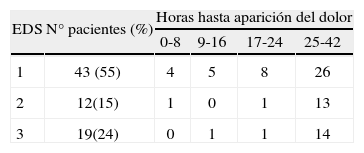Valorar la eficacia de los bloqueos nerviosos como técnica alternativa de analgesia postoperatoria en las prótesis de rodilla, señalando la validez y ventajas del abordaje por vía anterior del bloqueo ciático.
Material y métodoEstudiamos un grupo de pacientes consecutivos, desde abril de 2004 a marzo de 2006, intervenidos de artroplastia de rodilla, utilizando el bloqueo subaracnoideo como técnica anestésica y los bloqueos periféricos combinados femoral y ciático mediante su abordaje anterior como técnica analgésica postoperatoria. Valoramos el tiempo medio libre de dolor, calidad de la analgesia y estancia hospitalaria.
ResultadosIncluimos 78 pacientes. El intervalo libre de dolor del conjunto de todos los pacientes fue de 42,1±3,9h. Los pacientes que refirieron dolor leve, fue a las 34,8±4,1h y dolor moderado-intenso a las 42,4±3,5h. Alcanzaron 90° de flexión de la rodilla, al tercer día, el 62,8% de los pacientes. No hubo complicación derivada de la técnica y el grado satisfactorio de los pacientes fue alto.
ConclusionesEl bloqueo combinado femoral y ciático en cirugía protésica de la rodilla es eficaz, controla el dolor postoperatorio, permite una rehabilitación precoz. El abordaje anterior del ciático es relativamente sencillo de realizar sin retirar el vendaje compresivo del muslo tras la cirugía y además evita movilizar al paciente.
To evaluate the efficacy of a nerve block as an alternative technique for analgesia after knee arthroplasty and to indicate the usefulness and advantages of the anterior approach to the sciatic nerve block.
Materialand methodsBetween April 2004 and March 2006, we studied a series of consecutive patients undergoing knee arthroplasty in which a subarachnoid block was used as the anesthetic technique and postoperative analgesia was provided by means of a combined peripheral femoral nerve block and an anterior sciatic nerve block. We evaluated the mean length of time free from pain, quality of analgesia, and length of stay in hospital.
ResultsSeventy-eight patients were included in the study. The mean (SD) length of time free from pain for the group was 42.1 (3.9) hours. Patients reported mild pain after 34.8 (4.1) hours and moderate to severe pain after 42.4 (3.5) hours. By the third day, 62.8% of patients were able to bend the knee to 90°. There were no complications resulting from the technique and the level of patient satisfaction was high.
ConclusionsA combined femoral-sciatic nerve block is effective in knee arthroplasty. It controls postoperative pain and allows for early rehabilitation. The anterior approach to the sciatic nerve is relatively simple to perform without removing the pressure bandaging from the thigh after surgery. This approach also makes it unnecessary to move the patient.
Artículo
Comprando el artículo el PDF del mismo podrá ser descargado
Precio 19,34 €
Comprar ahora










